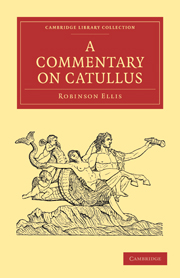A COMMENTARY ON CATULLUS: Pages 199-397
Published online by Cambridge University Press: 10 November 2010
Summary
53. It is not easy to decide between coluere and accoluere, the reading of Thuan. In 55 I have little doubt that accoluere is right, and it might be said that if read there it should be read in 53. Lachmann rejects it here, perhaps as less supported by MSS; but such variations are quite in accordance with the artificial usages of the school to which Catullus belonged: so fertur in 20 is responded to by lucet in 26, pepigerunt and pepigere occur in the same line 28.
54. ulmo marito, ‘to the elm as her husband,’ contrasts with Quintilian's maritam ulmum viii. 3. 8. Is it impossible that Catullus meant marito to be adjective, and notwithstanding retained the termination in o, where a feminine sign was out of place? Ennius used cupressus, Cato ficus masc. Servius on G. iv. 145 adds spinus, Priscian platanus populus laurus, Donatus pinus (Neue Formenl. i. 645); fagus seems to be masculine in a poem ascribed by Bûcheler to the age of Nero, Riese Anthol. L. 726: Horace uses lepus, Plautus elephantus feminine, where the notion of sex made it natural or necessary, S. ii. 4. 44, Stich. i. 3. 14: see Bentley on the former passage.
- Type
- Chapter
- Information
- A Commentary on Catullus , pp. 199 - 397Publisher: Cambridge University PressPrint publication year: 2010First published in: 1876

